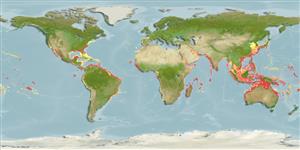Preferred temperature (Ref.
123201): 22.6 - 29, mean 27.4 °C (based on 1766 cells).
Phylogenetic diversity index (Ref.
82804): PD
50 = 0.5625 [Uniqueness, from 0.5 = low to 2.0 = high].
Bayesian length-weight: a=0.01995 (0.00943 - 0.04220), b=2.93 (2.75 - 3.11), in cm total length, based on LWR estimates for this (Sub)family-body shape (Ref.
93245).
Nível Trófico (Ref.
69278): 2.8 ±0.4 se; based on diet studies.
Resiliência (Ref.
120179): Médio, tempo mínimo de duplicação da população 1,4 - 4,4 anos (Assuming tm=3-4).
Fishing Vulnerability (Ref.
59153): High to very high vulnerability (66 of 100).
Nutrients (Ref.
124155): Calcium = 11 [4, 33] mg/100g; Iron = 0.455 [0.208, 1.128] mg/100g; Protein = 18.8 [16.5, 21.0] %; Omega3 = 0.127 [0.055, 0.272] g/100g; Selenium = 28.5 [9.5, 68.4] μg/100g; VitaminA = 18.5 [4.0, 84.0] μg/100g; Zinc = 0.626 [0.387, 1.062] mg/100g (wet weight);
